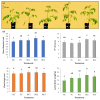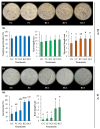Microbial Diversity of Psychrotolerant Bacteria Isolated from Wild Flora of Andes Mountains and Patagonia of Chile towards the Selection of Plant Growth-Promoting Bacterial Consortia to Alleviate Cold Stress in Plants
- PMID: 33807836
- PMCID: PMC7998784
- DOI: 10.3390/microorganisms9030538
Microbial Diversity of Psychrotolerant Bacteria Isolated from Wild Flora of Andes Mountains and Patagonia of Chile towards the Selection of Plant Growth-Promoting Bacterial Consortia to Alleviate Cold Stress in Plants
Abstract
Cold stress decreases the growth and productivity of agricultural crops. Psychrotolerant plant growth-promoting bacteria (PGPB) may protect and promote plant growth at low temperatures. The aims of this study were to isolate and characterize psychrotolerant PGPB from wild flora of Andes Mountains and Patagonia of Chile and to formulate PGPB consortia. Psychrotolerant strains were isolated from 11 wild plants (rhizosphere and phyllosphere) during winter of 2015. For the first time, bacteria associated with Calycera, Orites, and Chusquea plant genera were reported. More than 50% of the 130 isolates showed ≥33% bacterial cell survival at temperatures below zero. Seventy strains of Pseudomonas, Curtobacterium, Janthinobacterium, Stenotrophomonas, Serratia, Brevundimonas, Xanthomonas, Frondihabitans, Arthrobacter, Pseudarthrobacter, Paenarthrobacter, Brachybacterium, Clavibacter, Sporosarcina, Bacillus, Solibacillus, Flavobacterium, and Pedobacter genera were identified by 16S rRNA gene sequence analyses. Ten strains were selected based on psychrotolerance, auxin production, phosphate solubilization, presence of nifH (nitrogenase reductase) and acdS (1-aminocyclopropane-1-carboxylate (ACC) deaminase) genes, and anti-phytopathogenic activities. Two of the three bacterial consortia formulated promoted tomato plant growth under normal and cold stress conditions. The bacterial consortium composed of Pseudomonas sp. TmR5a & Curtobacterium sp. BmP22c that possesses ACC deaminase and ice recrystallization inhibition activities is a promising candidate for future cold stress studies.
Keywords: Andes Mountain; Curtobacterium; Patagonia; Pseudomonas; bacterial consortium; cold stress; plant growth-promoting bacteria; psychrotolerant bacteria; tomato.
Conflict of interest statement
The authors declare no conflict of interest.
Figures









References
-
- FAO . Frost Protection: Fundamentals, Practice and Economics. Food and Agriculture Organization of the United Nations; Rome, Italy: 2005. [(accessed on 3 February 2021)]. Available online: http://www.fao.org/3/y7223e/y7223e00.htm.
-
- Duman J.G., Wisniewski M. The use of antifreeze proteins for frost protection in sensitive crop plants. Environ. Exp. Bot. 2014;106:60–69. doi: 10.1016/j.envexpbot.2014.01.001. - DOI
Grants and funding
LinkOut - more resources
Full Text Sources
Other Literature Sources
Molecular Biology Databases

